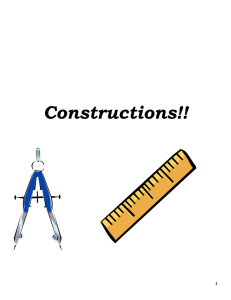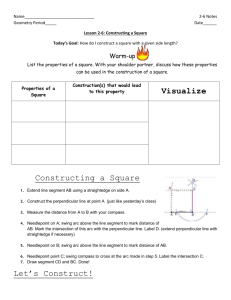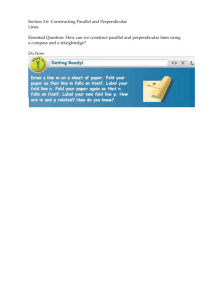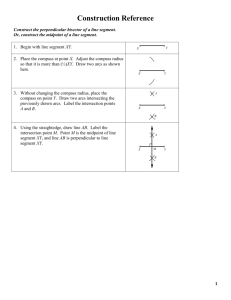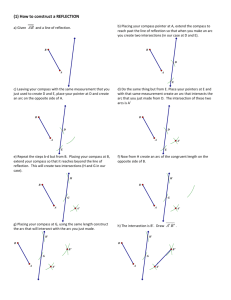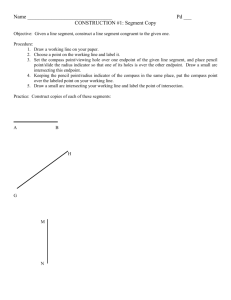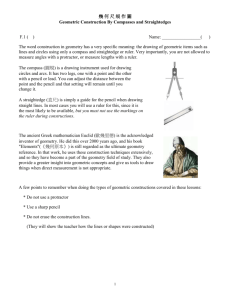Construction Reference
advertisement
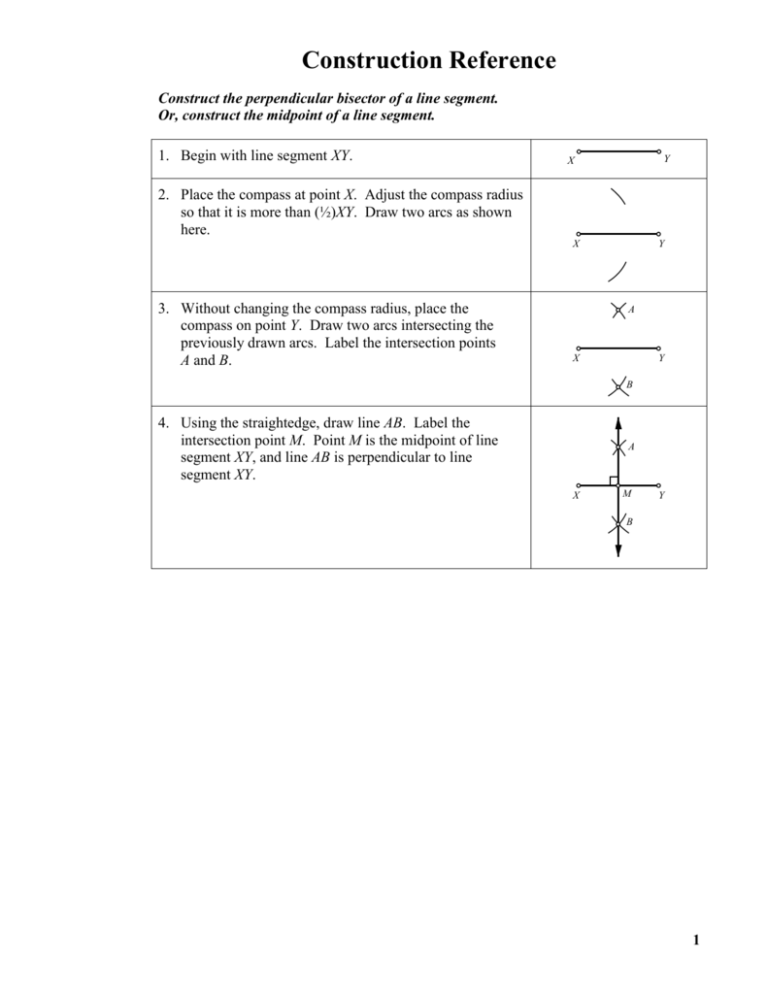
Construction Reference Construct the perpendicular bisector of a line segment. Or, construct the midpoint of a line segment. 1. Begin with line segment XY. Y X 2. Place the compass at point X. Adjust the compass radius so that it is more than (½)XY. Draw two arcs as shown here. X 3. Without changing the compass radius, place the compass on point Y. Draw two arcs intersecting the previously drawn arcs. Label the intersection points A and B. Y A X Y B 4. Using the straightedge, draw line AB. Label the intersection point M. Point M is the midpoint of line segment XY, and line AB is perpendicular to line segment XY. A X M Y B 1 Given point P on line k, construct a line through P, perpendicular to k. 1. Begin with line k, containing point P. k P 2. Place the compass on point P. Using an arbitrary radius, draw arcs intersecting line k at two points. Label the intersection points X and Y. k X P Y P Y 3. Place the compass at point X. Adjust the compass radius so that it is more than (½)XY. Draw an arc as shown here. k X 4. Without changing the compass radius, place the compass on point Y. Draw an arc intersecting the previously drawn arc. Label the intersection point A. A k X Y P 5. Use the straightedge to draw line AP. Line AP is perpendicular to line k. A k X 2 P Y Given point R, not on line k, construct a line through R, perpendicular to k. 1. Begin with point line k and point R, not on the line. R 2. Place the compass on point R. Using an arbitrary radius, draw arcs intersecting line k at two points. Label the intersection points X and Y. R 3. Place the compass at point X. Adjust the compass radius so that it is more than (½)XY. Draw an arc as shown here. 4. Without changing the compass radius, place the compass on point Y. Draw an arc intersecting the previously drawn arc. Label the intersection point B. k k Y X R k Y X R k Y X B 5. Use the straightedge to draw line RB. Line RB is perpendicular to line k. R k Y X B 3 Construct the bisector of an angle. 1. Let point P be the vertex of the angle. Place the compass on point P and draw an arc across both sides of the angle. Label the intersection points Q and R. Q P R 2. Place the compass on point Q and draw an arc across the interior of the angle. Q P R 3. Without changing the radius of the compass, place it on point R and draw an arc intersecting the one drawn in the previous step. Label the intersection point W. Q W P 4. Using the straightedge, draw ray PW. This is the bisector of QPR. Q W P 4 R R Construct an angle congruent to a given angle. 1. To draw an angle congruent to A, begin by drawing a ray with endpoint D. A D 2. Place the compass on point A and draw an arc across both sides of the angle. Without changing the compass radius, place the compass on point D and draw a long arc crossing the ray. Label the three intersection points as shown. 3. Set the compass so that its radius is BC. Place the compass on point E and draw an arc intersecting the one drawn in the previous step. Label the intersection point F. C B A D E C F B A D E 4. Use the straightedge to draw ray DF. C EDF BAC F B A D E 5 Given a line and a point, construct a line through the point, parallel to the given line. 1. Begin with point P and line k. P k 2. Draw an arbitrary line through point P, intersecting line k. Call the intersection point Q. Now the task is to construct an angle with vertex P, congruent to the angle of intersection. P k Q 3. Center the compass at point Q and draw an arc intersecting both lines. Without changing the radius of the compass, center it at point P and draw another arc. P k Q 4. Set the compass radius to the distance between the two intersection points of the first arc. Now center the compass at the point where the second arc intersects line PQ. Mark the arc intersection point R. P R k Q 5. Line PR is parallel to line k. P R Q 6 k
